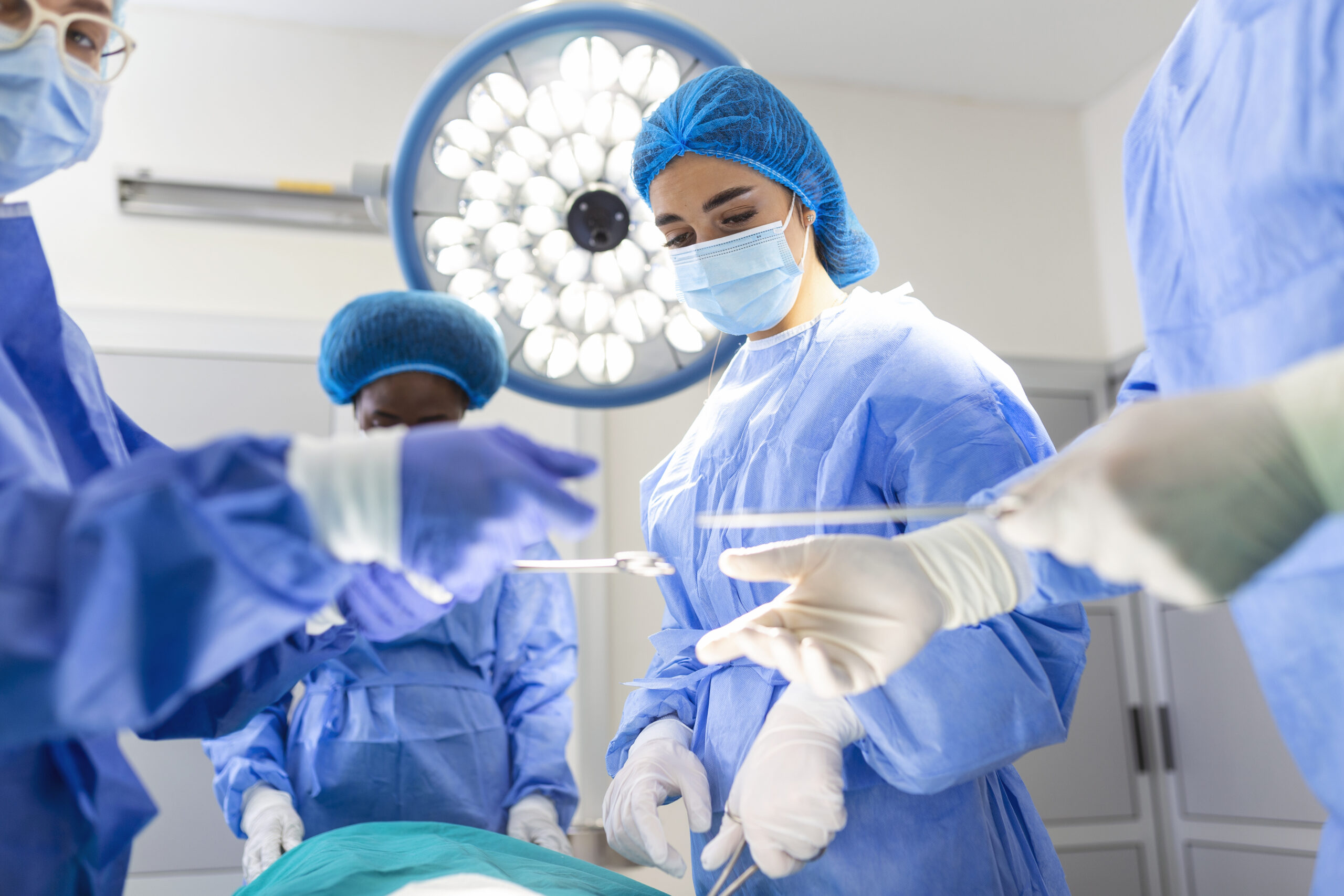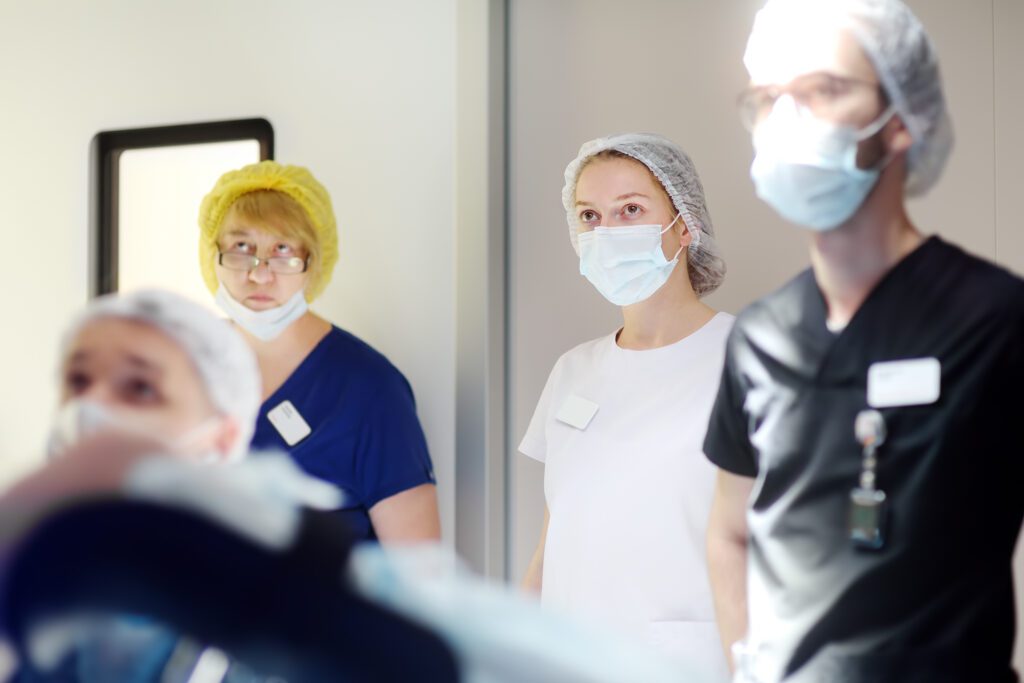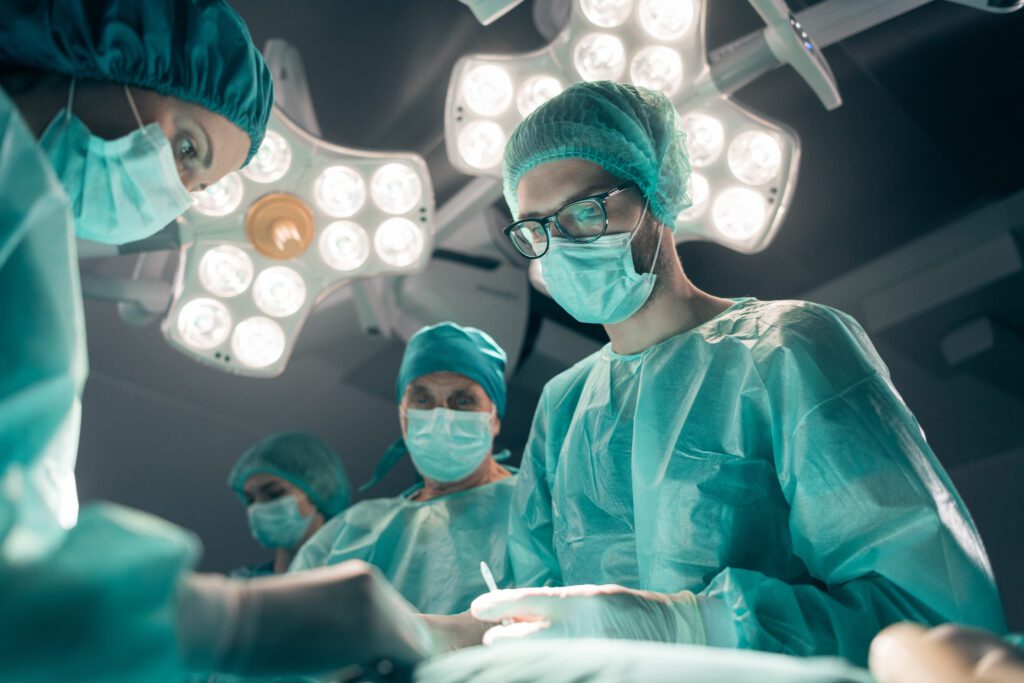Scrub Up: Tips for Your First Time in the OR
- by
- Nov 07, 2023
- Reviewed by: Amy Rontal, MD

Scrub up! If these words strike fear into your heart, you’re in good company. For most medical students, the first time they enter an operating room (OR) is during third-year clerkships. Nothing will quite prepare you for that moment, but some familiarity with the different roles, order of operations, etiquette, and expectations for medical students in the OR will help calm your nerves.
To help you get ready for your first day in the OR, we’ll go through what you can expect from start to finish. While it’s going to take some time to adjust to the unique environment of the OR, what follows can certainly help you navigate day one. So get ready, get prepped, and let’s walk through a day in the life of an MS3 on their first day of surgery rotation.
How to Crush Your First Day in the OR: Tips for Handling it From Start to Finish
Pre-Rounding & Patient Presentations
To get ready for rounds, you’ll need to arrive at the hospital very early on your first day of the surgery rotation. Unfortunately, this is likely to be around 4 am. Since surgeons are busy in the OR all day, they must round on patients before the first cases start at 7 am. For you, this means that you must pre-round and prepare your patient presentations in time for 5 am or 6 am.
“SOAP” Format Presentation
The good thing is that surgical rounds are short and sweet. Expect to do your usual “SOAP” format presentation with special attention to the following:
“S” – Subjective information about the patient
Is the patient nauseous or in severe pain? Some postoperative pain or site tenderness is normal, but pain out of proportion to what you’d expect for the procedure can indicate a complication like internal bleeding, perforation, abscess formation, compartment syndrome, etc.
“O” – Objective information about the patient
This includes:
Vitals overnight
Fevers and tachycardia can represent normal postoperative phenomena or something more sinister like an infection. A dropping blood pressure could represent dehydration or, more worrisome, shock.
Basic labs
Point out trends like a rising creatinine/BUN meaning the patient may require fluids, a rising white blood cell count hinting at infection, or electrolyte abnormalities suggesting malnutrition or a stunned bowel with poor absorption (ileus).
“A” – Assessment
Mention the patient’s name, age, hospital day, postoperative day, procedure (e.g., “status post cholecystectomy”) and your general assessment, i.e., do you think they’re improving, stable, or worsening?
“P” – Plan
This is the most difficult part for every medical student but it’s also the most fun because it’s where you flex your doctor muscles.
Low-hanging fruit for plans on a surgical service include:
Getting them out of bed/ambulating
Gone are the days when patients are put on bedrest after surgery. New research indicates that getting out of bed as soon as possible and moving around speeds up the healing process.
Advancing their diet
Patients will advance from a diet of clear liquids, to full liquids, to soft foods, and finally to a regular diet. They may need changes to their tube feeds or IV feeds (called TPN, or total parenteral nutrition).
Stopping or starting IV fluids
See if the patient is dry or puffy and take the appropriate steps.
Determining if they need more surgery
Patients with severe infection or burns may need repeat debridement or grafting.
Determining if other specialists need to get involved
Common consultants for surgical teams include infectious disease, medicine, and other surgical subspecialists in the area that was operated on. This is particularly true of transplant or surgical oncology cases which tend to be very interdisciplinary.
Discussing barriers to disposition
What’s keeping them from getting out of the ICU, step-down unit, or home altogether? Often it’s eating normally, passing gas (“flatus”), bowel movements, or having pain/nausea that requires IV medications only available in the hospital. They may also still require wound care dressings or a wound vac with plans to continue this care outpatient.
You’ll start to pick up on patterns as the days and weeks go on, but this is a good list to start!
Pre-Op & Meeting With Patients
Congratulations! You’ve survived rapid-fire surgical rounds. Now it’s time to get to pre-op and meet your patients.
You should introduce yourself to them in the pre-op area. Let the patient know your role, that you’ll be observing their case, and that you’re happy to answer any questions to the best of your ability. As a medical student, you have a real opportunity here to make a difference for patients who are anxious before surgery. You can be a source of reassurance and familiarity before they get rolled back to the OR.
Check out this blog post for more detailed instructions about how to introduce yourself to patients during rotations!
The anesthesiologist will also come in to explain their role and may give some anxiolytics or sedatives before the patient is rolled back to the OR on a stretcher.
Welcome to the OR!
Then you’ll accompany your patient back to the OR. Make sure you have on hospital scrubs, booties over your shoes (or alternatively, OR clogs), your mask, and a hair cap. You won’t be let into the OR suites without your full personal protective equipment (PPE) in place. Hopefully, you ditched the short white coat back in the workroom.
Once the patient is in the OR, things will start happening around you. A well-run OR is a wonderful thing to witness because everyone has a very defined role. As a medical student who often feels in the way with a very amorphous job, you may grow to like the mechanical feel of the OR.
Get to Know the Team
Some of the masked faces you’ll encounter in the OR include:
The circulating nurse
The circulating nurse person will stay unscrubbed for the entire procedure. Since they are not “sterile,” they can’t touch anything that’s sterile. This frees them up to do a variety of tasks during the case, which may include getting extra supplies, recording events in the computer, adjusting lights/music (surgeons are particular about their playlists), calling the blood bank/pathology lab/micro lab, etc., returning pages coming in for the residents/attending, and many other roles.
The scrub tech
The scrub tech is the opposite of the circulating nurse. They’re responsible for maintaining the sterile field and policing all the sterile people. They’ll help you get scrubbed in when the time comes and will be watching you very closely during the case to ensure you don’t break the sterile field.
By the way, the “sterile field” refers to anything that has been cleaned and draped with a sterile cloth or tarp or has come from a sterile package. This includes certain equipment in the room, the tools used during surgery, the surgeon gowns/gloves, and of course, the patient!
The anesthesiologist
Once the patient is on the stretcher and sedated in the OR, everyone gets to work. The anesthesiologist or nurse anesthetist inserts whatever IV access they need during surgery, which may include a central line or peripheral lines. A case that’s expected to be bloody or require pressors may involve more points of access. They’ll likely insert an arterial line which is an invasive way to monitor the blood pressure constantly via a catheter in the radial artery of the wrist.
Anesthesiologists are NOT scrubbed in and sit behind a curtain at the patient’s head. It’s the anesthesiologist’s job to keep the patient safe during surgery—they constantly monitor the patient’s vitals and sedation state so they can make adjustments. They have the authority to cancel a case if they don’t feel that a patient can be safely extubated, their morning labs are worrisome, or something else concerns them.
Likewise, if a patient codes or starts having a complication, the anesthesiologist runs the resuscitation effort. There are even branches of anesthesiology like obstetrics anesthesia and cardiac anesthesia which require special training and expertise to handle complex, high-risk cases.
Time to Scrub Up!
While everyone is setting up, make sure you keep track of what the resident is doing so you can take cues from them. When the resident steps outside the OR to “scrub up” at the sinks, you should too. Pay close attention to how they sanitize the fingernails and clean all the way up the arm. There’s also a particular technique to drying your hands with a towel to ensure you’re only touching the clean towel. I highly recommend watching a few YouTube videos on the process before you start your rotation.
When you return to the OR, make sure you don’t touch anything with your newly cleaned hands and arms. The scrub tech will assist you in finishing drying off, putting on sterile gloves, and getting your sterile gown on. At any point in this process you may break the sterile field, and they may ask you to rescrub or put on an extra sterile sleeve. If this happens, don’t freak out. It’s okay! It’s all in the best interest of the patient and everyone—including the attending surgeon—has broken the sterile field and been asked by the scrub tech to reclean or drape.
Preparing for Questions
Now it’s finally time for the case! Hopefully you prepared the night before or in pre-op for what you’ll be seeing. Surgeons are notorious for asking questions, often called “pimping” during cases.
It’s good to acquire some basic knowledge, but overall you shouldn’t stress too much about this. Your priority as a student is to take good care of your assigned patients, work well with the residents, and do well on your surgery shelf exam. If you don’t know the answer to an esoteric question about a procedure the surgeon has been performing for decades, don’t let it rattle you.
Still, you should study some basics commensurate with your level of training. For example, I recommend reading the patient’s chart to see what surgeries they’ve had in the past and what workup they’ve had so far for their condition. You should also research the procedure itself, the steps involved, the indication, and the recovery.
Finally, be sure you study the anatomy of the area itself. The surgeon may ask you about any of this, especially the anatomy, so it’s best to be prepared. You also will get much more out of the experience if you have some background on what’s going on.
 Looking for extra help while studying for your shelf exams? Meet the new combined Step 2 & Shelf Exams Qbank with 5,000 practice questions that most closely match what you’ll see on your USMLE Step 2 and all of your shelf exams. Get started with 7-day FREE access!
Looking for extra help while studying for your shelf exams? Meet the new combined Step 2 & Shelf Exams Qbank with 5,000 practice questions that most closely match what you’ll see on your USMLE Step 2 and all of your shelf exams. Get started with 7-day FREE access!
What You’ll Be Doing
During the case, you may be asked to do any number of things, such as retracting skin so the field is easier to see or suctioning blood or fluid out of it. At the end of the case, the resident will typically close the wound by suturing the patient. Many residents will even allow the medical student to suture the patient closed, especially if it’s a laparoscopic surgery where there are few sutures to be thrown.
Try to practice before your rotation! You can buy a practice suturing kit online that comes with tools, suturing, and silicone fake skin. Self-studying for this is very easy, since there are plenty of YouTube videos on how to throw all sorts of sutures. After a while, it’ll be a rote activity you can practice while watching TV. You’ll be glad you worked out the suturing kinks in the comfort of your living room before everyone is watching at the end of the case.
A couple more things before we wrap up: I recommend you start out with shorter cases if possible so you can get used to being in the OR. It’s also a good idea to have a snack or use the bathroom before a case begins. After all, once you’re “scrubbed in,” you’re committed to it. If you really need to leave the OR because you’re starving or have to use the restroom, you may not be able to scrub back in.
Be sure to speak with your clerkship director before the rotation if you have any extenuating circumstances like diabetes, pregnancy, IBS or any other reason why standing for several hours without food or a bathroom break isn’t doable so accommodations can be made. It’s also wise to speak with the residents and attending physician before each case so they know you’ll be leaving at some point.
Further Reading
You’re not alone if you’re a bit worried about starting your surgery rotation. But you’ve come this far, and you have what it takes to succeed! Follow these tips for handling your rounds, pre-op, and what to do once you get into the OR and you’ll hit the ground running.
Good luck, and don’t get nervous when someone says “scrub up.” Now you know what to expect!
For more (free!) content from Blueprint tutors to help you during your clinical rotations, check out these other posts on the Med School blog:
About the Author
I'm originally from the Northeast but attended college and medical school in Virginia. I just started residency in Internal Medicine this past year and am enjoying tutoring with Blueprint in my free time! I have always felt drawn to mentoring, especially when it comes to helping students like me who have no family in medicine to guide them. Now as a tutor at Blueprint, I’ve spent hundreds of hours teaching students at all levels. I think a lot about medical education and am excited to share my reflections on all things medical school and residency. In practice, I enjoy general medicine and as a bilingual physician find it especially rewarding to care for Spanish-speaking patients. When I’m not in the hospital, I enjoy salsa & bachata dancing, traveling to South America, dogs, and spicy food.









